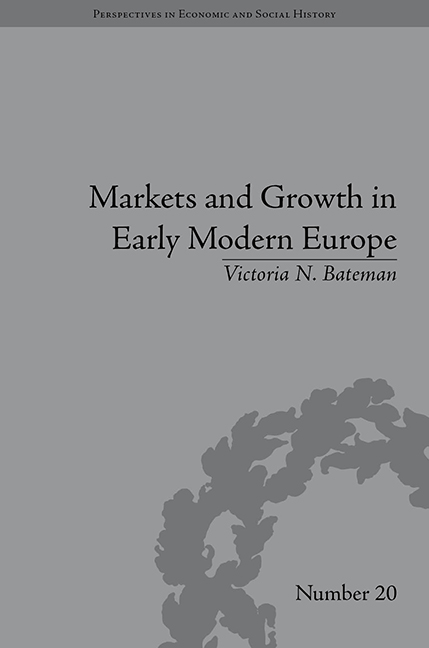Book contents
- Frontmatter
- CONTENTS
- List of Figures and Tables
- Acknowledgements
- Preface
- Introduction
- 1 Markets in History: A Survey
- 2 The Course of Early Modern Market Integration: Country-Level Results
- 3 The Course of Early Modern Market Integration: The Mediterranean and the North-West Region
- 4 Early Modern Market Integration in a Longer Run Perspective
- 5 The Causes of Early Modern Market Integration and Disintegration
- 6 The Consequences of Early Modern Markets: An Examination of the Relationship between Markets and Economic Growth
- 7 Conclusions and Implications for Economic Policy and the Modern Day
- Notes
- Works Cited
- Index
6 - The Consequences of Early Modern Markets: An Examination of the Relationship between Markets and Economic Growth
- Frontmatter
- CONTENTS
- List of Figures and Tables
- Acknowledgements
- Preface
- Introduction
- 1 Markets in History: A Survey
- 2 The Course of Early Modern Market Integration: Country-Level Results
- 3 The Course of Early Modern Market Integration: The Mediterranean and the North-West Region
- 4 Early Modern Market Integration in a Longer Run Perspective
- 5 The Causes of Early Modern Market Integration and Disintegration
- 6 The Consequences of Early Modern Markets: An Examination of the Relationship between Markets and Economic Growth
- 7 Conclusions and Implications for Economic Policy and the Modern Day
- Notes
- Works Cited
- Index
Summary
Having measured market development and understood what drives it, we are now in a position to formally test whether markets are responsible for the rich and sophisticated economy we inhabit today. Using the estimates of market development arrived at in previous chapters, including price gaps, price volatility and speeds of market adjustment, this chapter formally investigates whether economic performance at the country and city level in the period of Europe's rise between 1400 and 1900 can be explained by improving markets. Given the scarcity of historical estimates of income and growth, a range of measures of economic development are considered, including urbanization, real wages, agricultural productivity and population. The results suggest that markets were far from enough to enable sustained economic growth and that the improvements in markets taking place in the eighteenth and nineteenth century were a consequence as opposed to cause of growth. The chapter goes on to explore other factors that have been suggested by the literature, including institutions, the Enlightenment, factor prices and trade. We find that the development of the state, the Enlightenment and factor prices – instead of markets – were the key factors explaining the start of sustained economic growth in history.
The Relationship between Markets, Income and Growth in Europe: 1400–1850
As is strikingly shown by Maddison's historical estimates of GDP p.c., displayed in Figure 6.1, sustained economic growth is a relatively recent phenomenon.
- Type
- Chapter
- Information
- Markets and Growth in Early Modern Europe , pp. 149 - 166Publisher: Pickering & ChattoFirst published in: 2014

